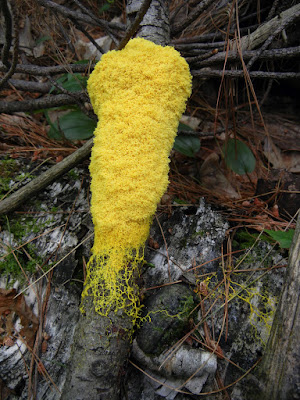I was out with Ruby last summer when I spotted
an unusual patch of colour in the distance, a pale, pretty, pinkish violet
perched atop a moss-covered oak log.
 |
| Ruby with Daedaleopsis confragosa and Hypoxylon fragiforme |
Now, Ruby is a fabulous foray companion — not only does she make me
laugh, I can also count on her to give me warning of approaching wildlife, such
as bears, when I’m silently concentrating on fungal marvels. Now that she’s
outgrown her jubilant puppy habit of pouncing directly on top of whatever exciting
specimen I happen to be focusing my camera on, she is almost perfect.
 |
| Ruby is a log-walker. |
I knew I had to distract her, so I gathered a few sticks
and began throwing them until I reached my quarry. What I found was a large patch of
not-quite-set, but fully-formedslime mold, Fuligo septica, but a F. septica that was, of
all things, a beautiful lavender instead of bright or dull yellowish.
 |
| Immature violet Fuligo septica |
 |
| Immature violet Fuligo septica showing pale pink plasmodium |
 |
| Violet Fuligo septica two days later |
Having reached the limit of what I could find
on line, I sent photos to Michael Warnock, one of the myxomycete aficionados
of my local club, the Mycological Society of Toronto. Michael replied with the suggestion that my
specimen might be a F. septica that had been attacked by the myxomycophagist
(slime mold eater), Nectriopsis violacea. I’ve actually found this curious
character before. It looks completely different than what I’d found.
 |
| Nectriopsis violacea, an ascomycete, feeds on Fuligo septica. |
N. violacea is an ascomycete that specifically
targets F. septica. It’s not terribly common — I’ve only seen it twice, both
times at the Cain Foray near Algonquin Park in Ontario — but it’s unmistakable.
Its colour ranges from dark purple to purplish white (not pinkish lavender), peppered
with minute darker pimples, the perithecia through which its spores are
released. Not what I had found.
 |
| A squash-mounted perithecium of Nectriopsis violacea along with globose spores of Fuligo septica |
In my neck of the woods, I more often encounter a yellower, more compact version that matures from sometimes startlingly yellow, huge masses of plasmodium, a stage that gave rise to another descriptive moniker, Scrambled Egg Slime. This plasmodium sometimes matures into large, dull-yellowish amorphic patches on logs and trunks of trees. Other times it separates into much smaller, individual, deep cadmium yellow pillows. All of the above forms contain dark purplish brown masses of globose, minutely spiny spores that all look the same microscopically. None of these forms are pinkish violet. Not even close. But I did read that the final colour can have a connection to the acidity of the substrate on which its aethalia (pillow-shaped fruiting bodies) have chosen to form.
 |
| A metre-wide patch of Fuligo septica plasmodium, also known as Flowers of Tan |
 |
| Spores of violet Fuligo septica showing oil droplets |
 |
| My spore-growing experiment produced brief pigmented growth. |
 |
| Normal egg-yolk yellow Fuligo septica plasmodium |
Many thanks to Michael Warnock, Frederick W. Spiegel, and Steven L. Stephenson!
 |
| Three stages of a pale yellowish beige Fuligo septica |
References & Resources
Steven L. Stephenson, Myxomycetes : a handbook of slime molds, Timber Press, 1994.Patricia M. Scholes: Some Observations on the Cultivation, Fruiting and Germination of Fuligo septica, J . Gen. Microbiol. (1961), 29, 137-148
Tom Volk's entertaining Fuligo septica page
Some fun Fuligo septica history from Historical and Literary Botany: Containing the Qualities, Anecdotes, and supperstitions, relative to trees, plants, and flowers, which are mentioned in sacred and profane history - Volume 3 By Eliza P. Reid 1826
Great series of photos from Wayne’s World of the different stages of pale version of F. septica plasmodium growing on wood chip mulch
Great series of photos from Wayne’s World of the different stages of pale version of F. septica plasmodium growing on wood chip mulch
The Myxomyceticolous Species of Nectria: Gary J. Samuels Source: Mycologia, Vol. 65, No. 2 (Mar. - Apr., 1973), pp. 401-420
An amazing BLUE Fuligo!!!






I found a pink pile of what I could only guess was a variety of f. skeptics just two days ago. I'd be happy to collect some for research- if it's still there. It was on or near a public trail. I can send a picture if you'd like.
ReplyDeleteWould love to see a picture. Also love spellcheck—skeptics! Good one!
ReplyDeleteha! I didn't notice the spellcheck-what's your email? I am queenthumbcreations@gmail.com.
ReplyDelete